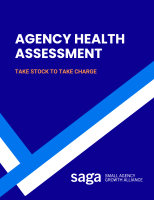Does your PR or marketing agency have a client concentration problem? What is that anyway? And what do you do to fix it?
That’s what Chip Griffin explores in this Small Agency TV segment.
Related
The following is a computer-generated transcript. Please listen to the audio to confirm accuracy.
What is a client concentration problem and why should you care? That’s what I’m talking about today.
So as a PR and marketing agency owner, I’m sure you have heard the term from someone client concentration, and you’ve heard that it’s a problem. And you say to yourself, well, what exactly does that mean? And client concentration is something that you do need to worry about as an agency owner, because what it goes to is the risk that your agency is incurring that too much of your revenue is tied to too few individual clients.
And so how do you figure out if you have a client concentration problem? The first thing you need to do is to look at if you have a single client that’s more than 20 to 25 percent of your total revenue. I generally prefer to see more like 15 percent as your ceiling, but 20 to 25 percent clearly indicates that you have a client concentration problem.
As that percentage goes higher, I’ve seen agencies where it’s 50 or 60 percent of the annual revenue is tied to a single client, and that’s a huge client concentration problem and a major risk. Something you absolutely need to be concerned with. So that’s one client concentration problem. The other is if your clients are too interrelated.
And a lot of times when we’re a small agency and we’re just getting started, we’re building through our own personal networks. Who’s our network made up of? People that we’ve worked with in the past. So there’s probably some relationship even amongst those individual clients. I’ve known some agencies, for example, who have a whole bunch of different clients when you’re looking at their spreadsheet, their roster of clients.
But as you dig deeper, you find out that they have the same parent company as they move up through the corporate food chain. And so that’s still a client concentration problem. Even if you’ve got individual decision makers. within each division or brand. So that’s something that you need to look out for.
You can also have a client concentration problem within an industry. So, on the one hand, All of us agency consultants, or most of us, will encourage you to specialize in a particular niche. At the same time, if you are too specialized and you’re doing it in such a way that you don’t have any variety at all, then you’re putting yourself at risk from a client concentration, or really industry concentration.
So client concentration is something that you need to consider. But how do you address it? It’s easy for me to sit here and say, Well, geez, you shouldn’t have any client that’s over 20 to 25 percent. But what do you do? Well, what you have to do is you have to try to look to increasingly bring on clients that have higher revenue than those clients before them.
So, for example, if you’ve got that client, that whale of a client who represents 25, 30 percent of your revenue. You then want to start looking at those smaller clients that you have, the ones that may be one or 2 percent of your revenue. And what you want to do is as those clients cycle out, as they inevitably do, you want to replace them with larger engagements.
So if your small engagements now are 1, 000 a month or 2, 500 for a project or something like that, try to get that up to more like 2, 000 a month, 5, 000 per project. And if you gradually increase the size of those smaller engagements, it will gradually diminish the concentration that you have in your biggest projects.
Now, this is not a quick process. It’s not an overnight process. The mistake that I often see people make is that they go in and immediately try to get other clients of the same size as those clients that have the high concentration of their current revenue. And that sounds appealing. That It feels like if I could just bring on another big client, that would be a quick way to dilute it.
But unless you’re dealing with all of your engagements of the same size, and they’re all large, then what you’re really doing is you’re now making yourself top heavy for two clients that are then going to put you at risk. And you’re, the client concentration problem isn’t just about the risk of what happens when that client goes away.
It’s It’s the risk of the decisions that you make because they represent such a significant percentage of your revenue. It’s inevitable. If you’ve got someone who’s 30, 40 percent of your annual revenue, if they ask you to jump, you’re going to say, how high? And that means that you’re going to likely over service them.
It means that you’re likely going to be diminishing your profit margin. on that work. So not only do you have the risk that the overall revenue is going to go away, but you’re eating into your own profits along the way. Quite often you’ll take a look at what you’re doing as an agency and you’ll find that your biggest clients aren’t your most profitable ones.
So if you have a client concentration issue, really large client, really low profit margin, that can be a deadly combination that really inhibits the growth of your agency and puts it at risk. In the event that something happens to that relationship. So client concentration is something that you need to be thinking about.
You want to be looking at it consistently and trying to figure out what your strategy is for diversifying your client base. You don’t want to limit it to just the single invoice or single decision maker. You want to look and see are there. Interrelationships here such that if one of those clients is becomes at risk, it puts other risk either because of personal relationships or because of industry status.
So if you take a look at those things, if you understand those things, you’ll be in much better shape to address, address client concentration, to put yourself in a much stronger position to generate profits and reduce your risk. Thanks for joining me today. If you’d like to learn more, visit smallagencygrowth.com and you can join the SAGA community for free, get together with other small agency owners, and take advantage of all of the resources that we have to offer. If you liked this video, please hit the like button and I look forward to seeing you back here again very soon.









